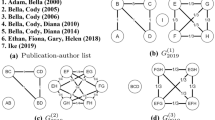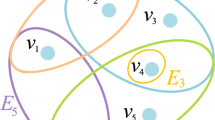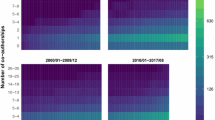Abstract
Social impacts and degrees of organization inherent to opinion formation for interacting agents on networks present interesting questions of general interest from physics to sociology. We present a quantitative analysis of a case implying an evolving small size network, i.e. that inherent to the ongoing debate between modern creationists (most are Intelligent Design (ID) proponents (IDP) and Darwin’s theory of Evolution Defenders (DED)). This study is carried out by analyzing the structural properties of the citation network unfolded in the recent decades by publishing works belonging to members of the two communities. With the aim of capturing the dynamical aspects of the interaction between the IDP and DED groups, we focus on two key quantities, namely, the degree of activity of each group and the corresponding degree of impact on the intellectual community at large. A representative measure of the former is provided by the rate of production of publications (RPP), whilst the latter can be assimilated to the rate of increase in citations (RIC). These quantities are determined, respectively, by the slope of the time series obtained for the number of publications accumulated per year and by the slope of a similar time series obtained for the corresponding citations. The results indicate that in this case, the dynamics can be seen as geared by triggered or damped competition. The network is a specific example of marked heterogeneity in exchange of information activity in and between the communities, particularly demonstrated through the nodes having a high connectivity degree, i.e. opinion leaders.
Similar content being viewed by others
References
Newman, M. E. J., Watts, D. J., Strogatz, S. H., Random graph models of social networks, Proceedings of the National Academy of Sciences of the USA, 99(S1) (2002) 2566.
Pastor-Satorras, R., Vespignani, A., Evolution and Structure of the Internet: A Statistical Physics Approach, Cambridge University Press, Cambridge, 2004.
Pastor-Satorras, R., Rubi, M., Diaz-Guilera, A. (Eds), In: Statistical Mechanics of Complex Networks, Lecture Notes in Physics vol. 625, Springer, Berlin, 2003.
Weidlich, W. Synergetic modelling concepts for sociodynamics with application to collective political opinion formation. The Journal of Mathematical Sociology, 18 (1994) 267.
Hegselmann, R., Krause, U., Opinion dynamics and bounded confidence models, analysis and simulation, Journal of Artificial Societies and Social Simulation, 5 (2002).
Lambiotte, R., Ausloos, M. Coexistence of opposite opinions in a network with communities, Journal of Statistical Mechanics: Theory and Experiment, P08026 (2007).
Pekalski, A., A short guide to predator-prey lattice models, Computing in Science and Engineering, 6 (2004) 62.
Pekalski, A., A model of population dynamics, Physica A, 252 (1998) 325.
Girvan, M., Newman, M. E. J., Community structure in social and biological networks. Proceedings of the National Academy of Sciences of the USA, 99 (2002) 7821.
Marsili, M., Vega-Redondo, F., Slanina, F., The rise and fall of a networked society: A formal model, Proceedings of the National Academy of Sciences of the USA, 101 (2004) 1439.
Newman, M. E. J., The structure of scientific collaboration networks, Proceedings of the National Academy of Sciences of the USA, 98 (2001) 404.
Newman, M. E. J., Scientific collaboration networks. I. Network construction and fundamental results, Physical Review E, 64 (2001) 016131
Newman, M. E. J., Scientific collaboration networks. II. Shortest paths, weighted networks, and centrality, Physical Review E, 64 (2001) 016132.
Hellsten, I., Lambiotte, R., Scharnhorst, A., Ausloos, M. Self-citations, co-authorships and keywords: A new method for detecting scientists field mobility? Scientometrics, 72 (2007) 469.
Bruckner, E., Ebeling, W., Scharnhorst, A. The Application of Evolution Models in Scientometrics, Scientometrics, 18 (1990) 21.
Holyst, J. A., Kacperski, K., Schweister, F. Social impact models of opinion dynamics, Annual Review of Computational Physics, 9 (2001) 253.
Ausloos, M., Dirickx, M. (Eds), The Logistic Map and the Route to Chaos. Springer, 2006.
Galam, S., Majority rule, hierarchical structures, and democratic totalitarianism: A statistical approach, Journal of Mathematical Psychology, 30 (1986) 426434.
Sznajd-Weron, K., Sznajd, J., Opinion evolution in closed community, International Journal Modern Physics C, 11 (2000) 1157.
Pekalski, A. A short guide to predator-prey lattice models, Computer Sciences in Engineering, 6 (2004) 62.
Mann, J., Ott, S., Pesceli, H. L., Trulsen, J. Predator-prey encounters studied as relative particle diffusion. In: The Logistic Map and the Route to Chaos, Ausloos, M., Dirickx, M. (Eds), Springer. 2006, pp. 131–146.
Pekalski, A., Evolution of population in changing conditions, Physica A, 314 (2002) 114.
Bianconi G., Marsili., M. Clogging and self-organized criticality in complex networks, Physical Review E, 70 (2004) 035105(R)
Radicchi, F., Castellano, C., Cecconi, F., Loreto, V., Parisi, D., Defining and identifying communities in networks, Proceedings of the National Academy of Sciences of the USA, 101 (2004) 5287.
Lambiotte, R., Ausloos, M., Uncovering collective listening habits and music genres in bipartite networks, Physical Review E, 72 (2005) 066107.
Ball, P. H., Critical Mass: How One Thing Leads to Another. Heinemann/Farrar Straus & Giroux, 2004.
http://www.arn.org/blogs/index.php/3/2007/10/14/science-and-intelligent-design-to-be-discussed
http://www.brownalumnimagazine.com/november/december-2005/the-evolution-of-ken-miller.html
Pennock, R. T., Creationism and intelligent design, Ann. Rev. Genom., 4 (2003) 143.
Newman, M. E. J., Finding community structure in networks using the eigenvectors of matrices, Physical Review E, 74 (2006) 036104.
Lambiotte, R., Ausloos, M., N-body decomposition of bipartite networks, Physical Review E, 72 (2005) 066117.
Sprague De Camp, L., 1968, The great monkey trial, doubleday; see also http://www.pbs.org/wgbh/amex/monkeytrial/
CSC, see http://www.discovery.org/csc/
NCSE, see http://www.ncseweb.org/
Dembski, W., The Design Inference. Cambridge U. Press, 1988.
Behe, M. J., Darwin’s Black Box: The Biochemical Challenge to Evolution. Free Press, New York, 1996.
Dembski, W., Behe, M., Meyer, S., Science and Evidence for Design in the Universe. Ignatius Press, 2000.
Dembski, W. A., No Free Lunch: Why Specified Complexity Cannot Be Purchased without Intelligence. Lanham, 2002.
Behe, M. J., A response to reviews of Darwin’s black box: The biochemical challenge to evolution. Biological Philosophy, 16 (2001) 685.
Corey, M. A., The God Hypothesis: Discovering Design in Our Just Right Goldilocks Universe. Rowman & Littlefield Pub Inc, 2007.
Lewels, J., The God Hypothesis: Extraterrestrial Life and Its Implications for Science and Religion, Wildflower Press, 1997.
Dawkins, R., The Selfish Gene. Oxford Univ. Press, 1976.
Dawkins, R., The Blind Watchmaker: Why the Evidence of Evolution Reveals a Universe Without Design. WW Norton, 1986.
Dawkins, R., The God Delusion. Houghton Mifflin, 2006.
see http://en.wikipedia.org/wiki/Kitzmiller-v.-Dover-Area-School-District
Lee, B., Kitzmiller v. Dover area school district: Teaching intelligent design in public schools, Civil Rights-Civil Liberties Law Review, 41 (2006) 581.
Dewolf, D. K., West, J. G., Luskin, C., Intelligent design will survive Kitzmiller v. Dover, Mont. L. Rev., 68 (2007) 7.
Flom, P. L., Friedman, S. R., Strauss, S., Neaigus, A., A new measure of linkage between two subnetworks, Connections, 26 (2004) 62.
Rousseau, R., Q-measures for binary divided networks: an investigation within the field of informetrics. Proceedings of the 68th ASIST Conference, 42 (2005) 675–696; see also E-LIS: code 5265.
Chen, L. X., Rousseau, R., Q-measures for binary divided networks: bridges between German and English institutes in publications of the Journal of Fluid Mechanics, Scientometrics, 41 (2008) 57.
Author information
Authors and Affiliations
Corresponding author
Rights and permissions
About this article
Cite this article
Cantú, A.G., Ausloos, M. Organizational and dynamical aspects of a small network with two distinct communities: Neo-creationists vs. Evolution Defenders. Scientometrics 80, 457–472 (2009). https://doi.org/10.1007/s11192-008-2065-0
Received:
Published:
Issue Date:
DOI: https://doi.org/10.1007/s11192-008-2065-0




